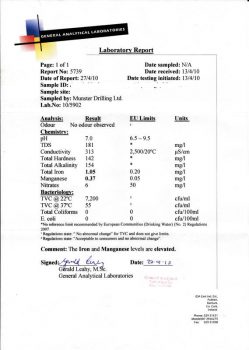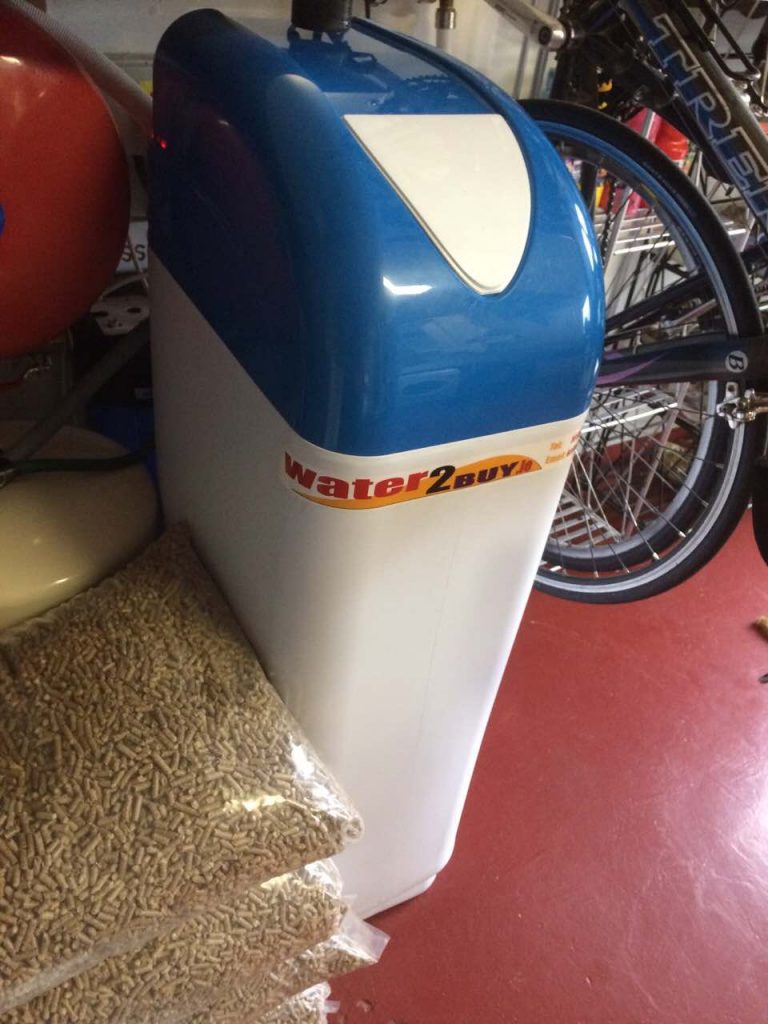Home water quality is important and for us it was an issue.
When we first built our house back in 2010 we opted for installing a well on our property as connecting to the local water mains was just too expensive – it was too far from our house to connect in at a reasonable cost. Plus the idea of having control over our own supply was in keeping with our self-sufficient approach.
When the well was sunk to a depth of 200ft we felt happy that the drainage through that amount of ground would do a good job of filtering  out any nasty stuff that the local landowners might want to dump on the land.
out any nasty stuff that the local landowners might want to dump on the land.
Unfortunately we were in an Iron rich area and so the water, although quite drinkable and clear had a relatively high iron and Mn content and also elevated hardness. Iron is classified as a secondary contaminant as it is does not impact health but is more a cosmetic and taste issue. When drinking a glass of water tastes like you have a bloody lip, then you just tend to avoid it!
On the advice or our plumber at the time, we went with some large passive filters to clean it up. This triple filter system (shown), used a first stage sediment mesh filter to remove particulates, a second stage carbon filter to remove contaminants by chemical adsorption and finally a third stage filter designed to remove Iron(Fe) and manganese (Mn).
 According to the supplier of the cartridges, which cost about Euros200 to replace, they should last up to a year for a house of 5 with typical consumption. Unfortunately for us we found that the problems with iron staining of our sinks, toilets and clothes never quite went away. In contrast, the hardness (Calcium carbonate) wasn’t much of an issue as it was not very high and it also adds a crisp freshness to the water flavor.
According to the supplier of the cartridges, which cost about Euros200 to replace, they should last up to a year for a house of 5 with typical consumption. Unfortunately for us we found that the problems with iron staining of our sinks, toilets and clothes never quite went away. In contrast, the hardness (Calcium carbonate) wasn’t much of an issue as it was not very high and it also adds a crisp freshness to the water flavor.
The carbon and sediment filters we installed appeared to be doing their job, but the iron filter simply wasn’t up to the task. On doing some research it seems there are different varieties of iron contamination in Irish water.
Water that comes out of the tap clear, but turns red or brown after standing contains “ferrous” iron. Water which is red or yellow when first drawn is “ferric” iron. Iron can form compounds with naturally occurring acids, and exist as “organic” iron. Organic iron is usually yellow or brown, but may be colorless. For the chemists: ferrous indicates Iron in a +2 oxidation state while ferric is iron in a +3 oxidation state. As far as we could tell, we had ferrous iron and the most commonly recommended way to remove it is by using a water softener (ion exchange resin based).
The presence of Mn will tend to create some black stains, and can give the water a bit of a bad smell, making your glass of water with meals even less appealing than the iron already makes it. Although both iron and manganese are harmless to health at these levels (1ppm and 0.37 ppm respectively), their combination in drinking water is a real problem – in that you won’t want to drink it. This is a bad situation with kids when you want to encourage to drink lots of water and less of the sugary alternatives.
When one goes looking for solutions, there seems to be much scaremongering about how specialized the water cleaning technology is. On making enquiries, we kept hearing that one daren’t make a purchasing decision without talking to “the experts” who want to sell you their specialized system that is perfect for your needs.
We received quotes from €900 to €1500 for a softener/ion exchange unit to fix our problem! Significantly more than we expected to pay for technology that seems really quite simple.
As with many other household technologies, the amount of available information online is helping to address the lack of information which forces buyers to be cornered into paying high prices. This is the rather excellent leveling effect of free information.
Armed with the knowledge that we had ferrous iron and manganese to remove as well as some hardness, we were able to avoid that first costly barrier of not knowing what we needed. That ignorance can unfortunately lead to some businesses taking advantage of those who come with a “can you understand and fix my problem for me” approach.
We found these guys (www.water2buy.ie) offered a high quality product and service designed for those willing to handle some of the leg work. Having spotted a sale price earlier in our searches, when we went back to finally make a purchase, that sale price was gone, but we were delighted that they were open to negotiation and in the end we got our new system delivered for €450 instead of the advertised €600. A whole lot less than our first enquiries forecasted.
The people at Water2buy.ie were able to assess our water analysis test results to confirm that this particular ion exchange resin would fix our problems which turned out to be correct. In the back of my mind I knew that once you have the hardware (a sealed cylinder, valves and plumping) that changing this particular resin for another option is relatively easy should there be issues later. So we felt quite happy to purchase without b eing able to confirm that it would do the job.
eing able to confirm that it would do the job.
It turned out to be one of those rare completely successful fixes! We are thoroughly satisfied and are iron/manganese/lime free after 1.5 years of running now. As with all ion exchange processes the ions being exchanges with the unwanted contaminants need to be replenished – usually with rock salt. Through use of low flow fittings/toilets throughout our house we are down to approximately 1 x 20kg bag every 2 months. We didn’t opt for the more expensive flow based meter to set the flushing frequency, and instead went for the time based meter which just flushes at preset times regardless of the consumption. With some tweaking we managed to get it down to the point where it’s just enough to maintain the resin and so not much salt is being wasted.
The installation was easy and cost €80 with a local plumber to fit the additional lines to put the filter inline and also allow a bypass for when we needed to work on it.

